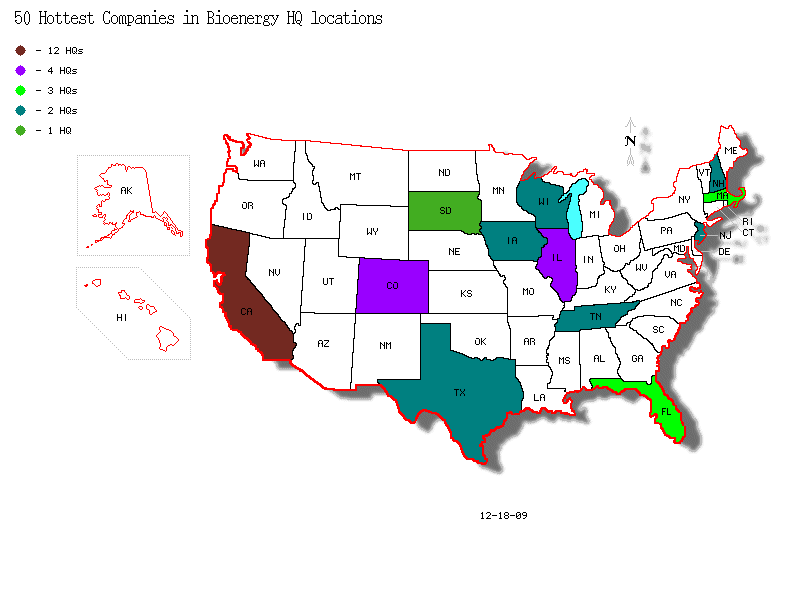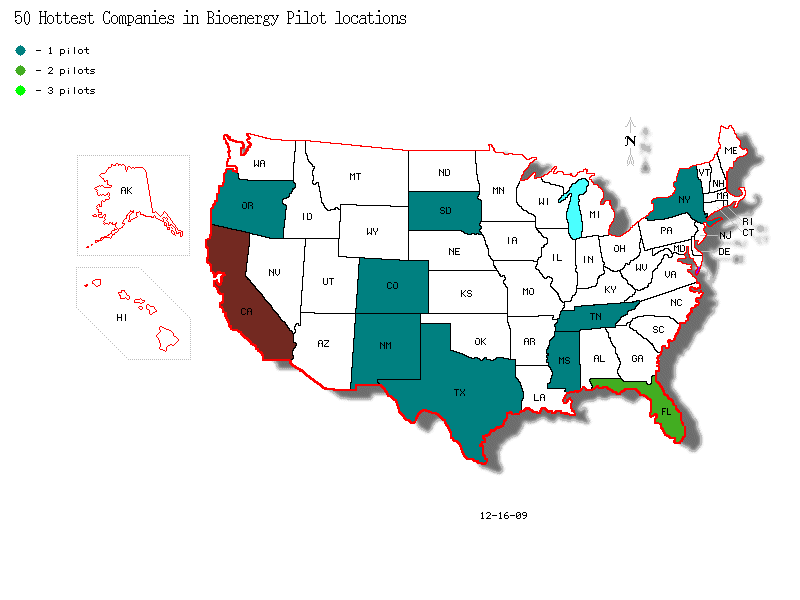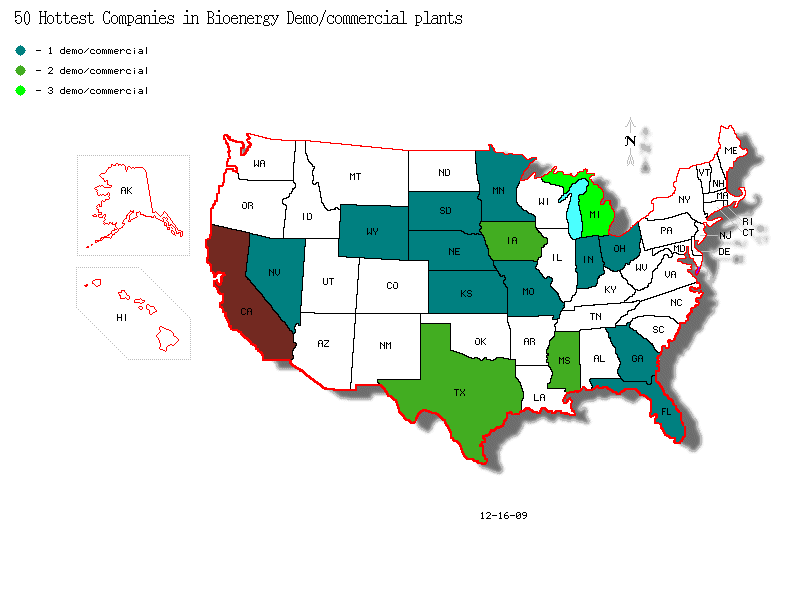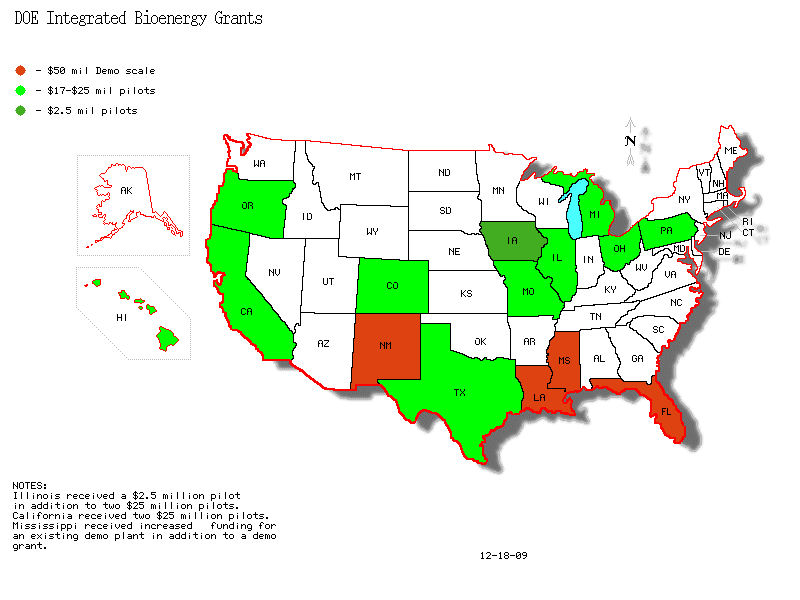In December Biofuels Digest published an article "
The Hottest 50 Companies in Bioenergy and the DOE Integrated Bioenergy Grants, in maps." They produced maps that represent:
1. Locations of the companies in their list of the "50 Hottest Companies in Bioenergy."
2. Locations of pilot-scale projects of these companies.
3. Locations of demonstration-scale and commercial-scale projects for these companies.
4. Locations of pilot and demonstration-scale projects that received support in the $564 million Department of Energy IBR grants, announced in December 2009.
Observe Arizona's status in each of these maps (I realize that the keys aren't legible in these thumbnails, but here's all you need to know: blank = zero).




Granted, Biofuels Digest focused on bioenergy broadly, not just on algae. Nonetheless, in my view these maps demonstrate a problem: Arizona is not on the map (literally and figuratively) when it comes to algae biofuels --
and we absolutely should be!Arizona should have owned solar: that is, we should be the leading region for solar in the way that Silicon Valley is the leader in information technology. For reasons I won't try to diagnose or analyze here, we aren't. We have a second chance, however, with "green solar" (to borrow
Mark Edwards' term for algae). I believe that algae is a fundamentally transformational technology, akin to the semiconductor in its potential impact. Arizona has an extraordinary opportunity to lead in connection with algae biofuels and related products and services (nutraceuticals, bioplastics, wastewater remediation, carbon capture, etc.).


Consider the assets we have available to us:
1. Unbeatable natural assets: (a) sun, (b) heat, (c) abundant cheap, flat land, and (d) plentiful briny aquifers (not useful for much else given their salinity) and wastewater.
2. Incredible world-class research efforts, including the highly acclaimed
[1] [2] work by Drs. Sommerfeld and Hu at
ASU Polytechnic and the impressive work at
ASU BioDesign. [4/23/10 update: the University of Arizona is also
emerging as a research leader.]
3. Leading algae entrepreneurs, including
XL Renewables (one of the few companies in the world to be currently producing algae for commercial sale, not just engaged in demo projects or research),
Diversified Energy,
Desert Sweet Biofuels, Energy Derived (
.pdf),
PetroSun (featured in the film
Fuel),
Heliae,
Bye Energy and
Algae Biosciences.
4. World-class policy analysts and thought-leaders, such as Mark Edwards (author of the award-winning and bestselling
Green Algae Strategy), Colleen Crowninshield at the
Tucson Clean Cities Coalition, Dave Conz and the team at ASU's
Consortium for Science, Policy and Outcomes (CSPO), and Sandy Askland and the team at ASU's
Center for the Study of Law, Science and Innovation.
5. Increasingly strong support from trade groups and NGOs such as the
Arizona Bioindustry Association,
Science Foundation Arizona and the
Flinn Foundation.
[4/23/10 addition: a commenter correctly noted that I neglected to mention two key pioneering efforts by APS: (1) the
2006 project at RedHawk, and (2) the $70M
carbon sequestration project at Cholla Generation Station.]
To date, despite these strong assets, Arizona has lagged behind as other regions have taken the lead in connection with algae. I'm hopeful that this is beginning to change, for several reasons:
1. The establishment of
ASU Lightworks under Gary Dirks can provide a focal point of leadership for the Arizona algae community.
2. The Algal Biomass Organization's
Algal Biomass Summit, an important national conference, will be held in Phoenix in September. This provides a unique opportunity to showcase Arizona as a leading region for algae technology.
3. Government stakeholders are beginning to engage. Progressive government entities such as the City of Phoenix and the Town of Gilbert have provided demonstrable/tangible support, and other local and state government entities appear increasingly interested in engaging in the fashion we've seen in other states.
Algae presents an extraordinary opportunity for Arizona. I hope that we can capitalize on it.
 We're thrilled that Sam West has rejoined us, stepping back into his role as our part-time executive director. Sam initially joined us in 2008 as a third year law student; after graduation he took on a leadership role for DBI, managing several key projects. As we noted then, Sam brings a unique and valuable set of skills to the table for DBI, drawing from his experiences as a civil engineer, his MBA and law degrees, and his leadership experience associated with his serving on submarines and other roles as an officer in the Navy.
We're thrilled that Sam West has rejoined us, stepping back into his role as our part-time executive director. Sam initially joined us in 2008 as a third year law student; after graduation he took on a leadership role for DBI, managing several key projects. As we noted then, Sam brings a unique and valuable set of skills to the table for DBI, drawing from his experiences as a civil engineer, his MBA and law degrees, and his leadership experience associated with his serving on submarines and other roles as an officer in the Navy.






